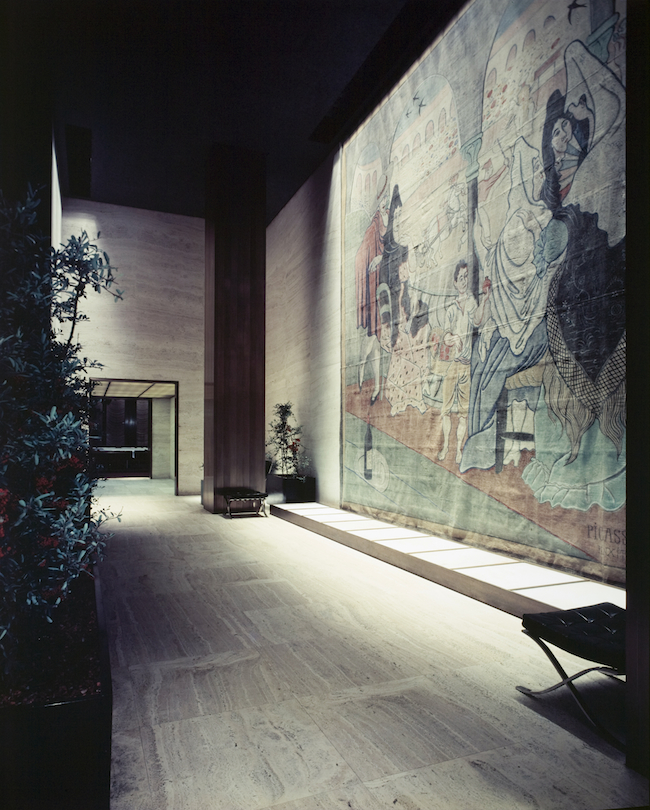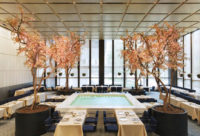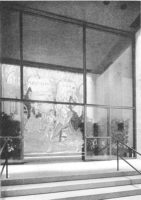
Photo © Ezra Stoller/Esto
Pablo Picasso originally painted Le Tricorne (1919), shown here in a 1959 Ezra Stoller photograph, as a backdrop for a Diaghilev ballet.
Editor's Note: On the afternoon of February 7, the New York Landmarks Conservancy won a temporary restraining order barring the removal of the Picasso described below from the Four Seasons restaurant. "The judge talked about how important this Picasso is to the cultural life of the city and he saw no reason for moving it now," says Peg Breen, the Conservancy's president. "And we explained that moving it would really damage it." According to Breen, at the hearing, the lawyer representing RFR Holding said, "If we break it, we'll pay for it," to which the judge reportedly replied, “If you break it, I’ll never see it again, and my children will never see it.” RFR declined to comment on the restraining order. Both parties will return to court on March 11 for a hearing.
I was startled to read in the New York Times about the plan to remove Picasso’s large curtain, Le Tricorne (1919), from the landmarked Four Seasons restaurant in the Seagram Building in New York. The reason, according to current owner RFR Holding, is the imminent failure of the travertine-clad wall against which the 19-foot-high curtain, originally painted as a backdrop for a Diaghilev ballet, is mounted. I was aghast—and surprised, as I am very familiar with this wall.
In 2008, my firm was hired as the architect for an ongoing restoration of the Four Seasons, at the recommendation of Phyllis Lambert, architect and daughter of the original client for the Seagram, Samuel Bronfman. Our work began with a thorough evaluation of existing conditions and an inventory of elements in the Philip Johnson-designed restaurant that needed attention. The travertine wall panels in "Picasso Alley," the elegant glassed-in passageway connecting the Grill Room and the Pool Room where the Picasso hangs, were not on the list of problems. Sure, some of the stone has shifted slightly out of alignment, as it has in the Seagram lobby generally (unremarkable after 50 years), but not to a degree that caused alarm.
The New York Landmarks Conservancy was deeded the painting in 2005 as a gift from Vivendi Universal—then owner of the Seagram company—with the proviso that it remain in situ. This past January, the Conservancy asked Thornton Tomasetti to render an opinion on the stability of the stone cladding. One of its engineers came to my office to examine the original drawings of the Four Seasons. (Nobody from Severud Associates, the structural engineers engaged by RFR Holding to assess the wall, contacted me.) I directed Thornton Tomasetti’s attention to an architectural plan that shows clearly that the travertine cladding is not on the wall behind the Picasso. The space was designed so precisely for the permanent installation of Le Tricorne that Johnson omitted the travertine finish. Thus, the terrible prospect of a slab of travertine delaminating from the wall and ripping through the curtain, as RFR claims, is utterly specious. Likewise, the building plans indicate no steam pipe or anything else in that wall that could be leaking and thus requiring invasive repair.
So what's going on? It seems that the building’s current owners, who bought the Seagram Building in 2000, just want the Picasso painting out of there. According to the Times, Aby Rosen, co-founder and principal of RFR, reportedly referred to the curtain as a "schmatte" (Yiddish for rag). Mr. Rosen is well known as an ambitious collector of contemporary art, and I, for one, am grateful to him for the way he has used his collection to animate the plaza and lobby of the Lever House, which he also owns, across Park Avenue from the Seagram. But I would hate to see him try to "improve" the view from the Seagram lobby into the Four Seasons with a new selection of art.
The Four Seasons—its finishes, furnishings, and the site-specific paintings and sculpture—is a total work of art, and Le Tricorne is as essential to the character of the place as the shimmering Richard Lippold sculpture that hovers over the bar. (Because the Picasso is theoretically a portable artwork, it regrettably could not be included in the restaurant’s interior landmark designation in 1989.) To remove Picasso's curtain—the backdrop not just for a ballet, but for 50-plus years of New York social history—from the Four Seasons would be nothing short of vandalism; and the dubious legitimacy of the stated reasons for doing so make the act all the more egregious.






Post a comment to this article
Report Abusive Comment